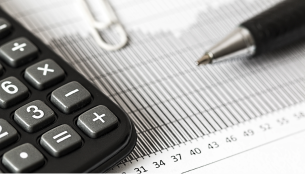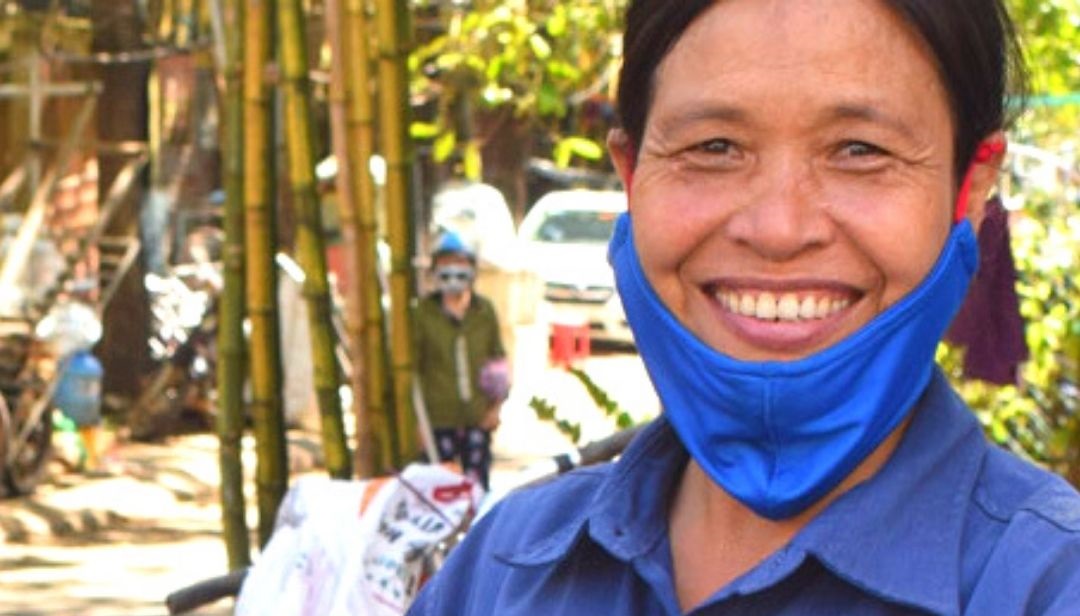The MRF – A solution to increase the rate of recovered plastic waste
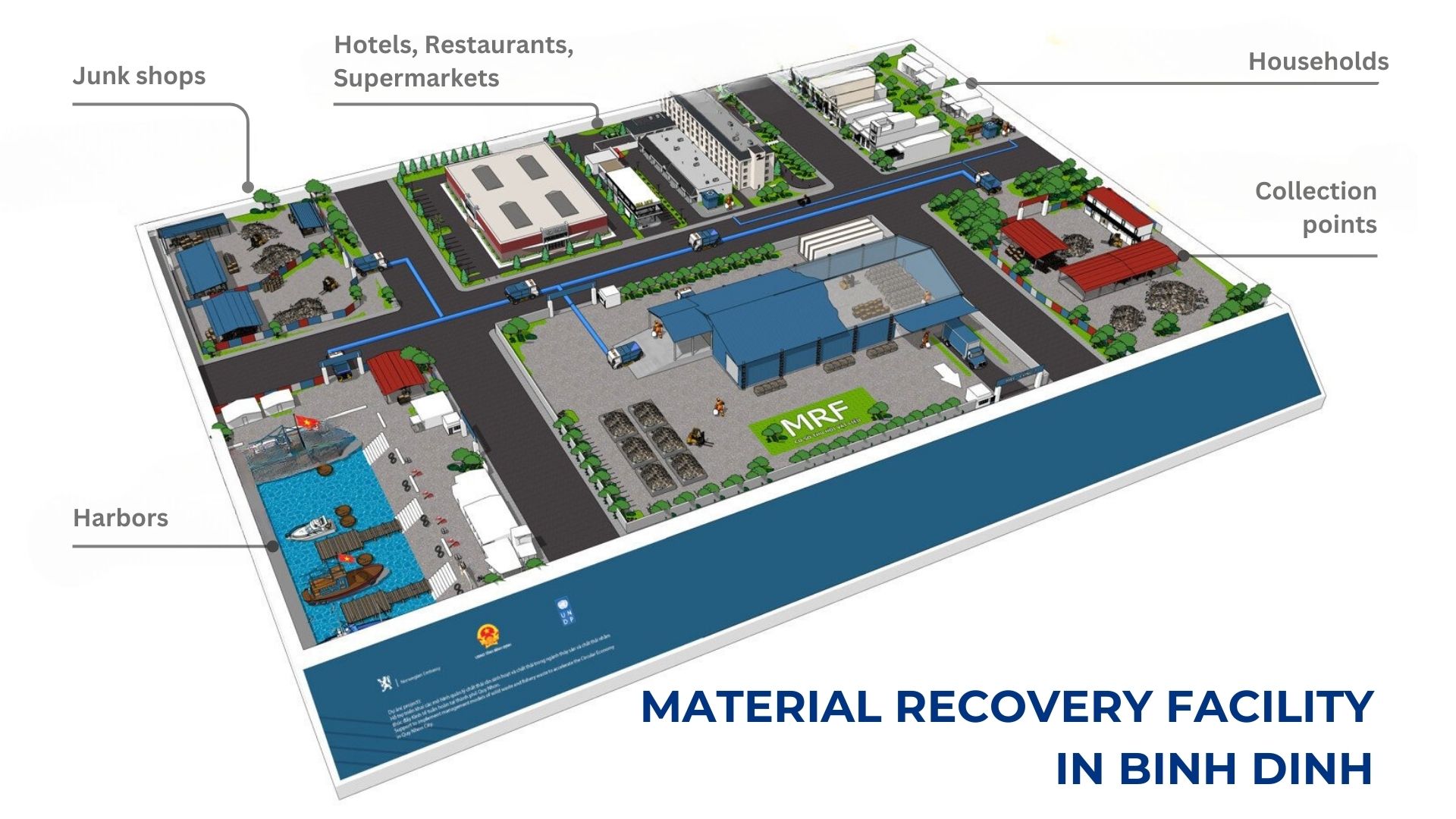
A simulation model of input plastic scraps for MRF
Viet Nam is projected to produce a staggering 52 million tons of household solid waste per year by 2025, with an annual growth rate ranging from 10% to 16%. According to the Viet Nam Plastics Association, plastic waste and nylon bags constitute approximately 8% to 12% of this waste, but only about 10% is properly processed and recycled. Binh Dinh province, positioned with a lengthy coastline, robust transportation infrastructure, economic zones, and abundant resources, aspires to emerge as a leading province in Central Viet Nam. Nevertheless, it faces a growing challenge: the escalating volume of domestic solid waste (MSW). A 2023 pre-feasibility study conducted by the United Nations Development Programme (UNDP) reveals that Quy Nhon city, located in Binh Dinh, generates roughly 32,000 tons of plastic waste annually. Alarmingly, only 2,044 tons of this waste are collected and recycled. This urgent situation is further highlighted by the Long My landfill, where an estimated 63 tons per day of plastic accumulate, including 5.9 tons of high-value plastic waste and 57.1 tons of low-value plastic.
In response to this pressing issue, UNDP is spearheading the “Scaling-up Integrated and Inclusive Waste Management Models through Empowering the Informal Sector and Fostering the Circular Economy” project (DWP5C Phase 2) with the support of the Norwegian Embassy. This initiative encompasses (i) the establishment of a Material Recovery Facility (MRF) to collect and recover plastic waste from various sources and thereby increase added value for plastic waste by sorting, cleaning and decontaminating, preliminary processing before selling it to recyclers; (ii) the implementation of an initiative to encourage fishing boats to bring onboard plastic waste back to shore, in conjunction with the construction of a warehouse and provision of supporting collection equipment; (iii) the advancement of informal waste workers’ engagement in waste management and their livelihood through the prior models.
The MRF – A solution to increase the rate of recovered plastic waste
The MRF is situated at Long My solid waste treatment area, Thanh Long village, Quy Nhon city, Bnh Dinh province. Spanning 1,000 m2, it is designed with a daily processing capacity of 02-04 tons of plastic, and the potential to increase production capacity to 5-10 tons/day based on Quy Nhon city’s plastic waste data. The MRF sources plastic scraps from various points, including fishing ports, hotels, supermarkets, households, scrap yards, and the Long My landfill with distinct methods of purchasing for each group.
Video introducing the MRF in Binh Dinh
The MRF processes PET plastic packaging and bags into bales, while other plastics (HDPE, LDPE, PE, PP, PVC) are sorted, crushed, washed, dried, and bagged. The output products are sold to recyclers, contributing to Quy Nhon city’s plastic scrap value chain and fostering a circular economy.
The MRF plays a crucial role in achieving environmental, economic, and social objectives. Environmentally, it strengthens collection, transportation, and preliminary processing, reducing plastic waste leakage, particularly low-value plastic waste. Economically, the MRF is designed to increase consumption efficiency of natural resources, especially in the context of plastic industry deprived of plastic recyclate and reducing landfill treatment costs. Socially, the project promotes green jobs, and particularly provides livelihoods for local informal workers when they participate in the MRF’s collection network and provide plastic waste as input materials for the MRF.
The MRF introduced into Binh Dinh is projected to recover an additional 2-4 tons of plastic per day, diverting 1 ton of waste from landfills and creating over 200 jobs in waste management, sorting, and recycling for local residents.
The MRF model is executed through the collaboration of numerous provincial agencies, with a particular emphasis on coordination with key entities such as Binh Dinh Provincial People’s Committee, Quy Nhon City People’s Committee, Binh Dinh Environment Joint Stock Company, and various departments, including the Department of Natural Resources and Environment, the Department of Construction, and the Department of Planning and Investment in approving strategies, organizing counterpart funds, and issuing relevant environmental and construction permits. Furthermore, in the course of designing the system and establishing the operational procedures for the MRF, consultants specializing in environmental, construction, and recycling were engaged. Their role was pivotal in selecting treatment technologies tailored to the local context and scene. Throughout these processes, UNDP assumes the responsibility of monitoring and evaluating the effectiveness of the activities, offering recommendations for adjustments to enhance the overall quality of the project.
Milestones in 2023
Under the DWP5C phase 2 project, two communication centers have been established at strategic locations: 40 Phan Boi Chau, Le Loi Ward, and 75 Nguyen Dieu, Nhon Phu Ward, both situated in Quy Nhon City. These centers serve as hubs collecting plastic waste materials from the local community. In a bid to incentivize collection, initiatives such as waste-to-gift redemption programs have been implemented, including events held on World Environment Day (June 5) and workshops introducing the MRF and the informal labor sector. As of December 2023, a noteworthy total of 800kg of plastic scrap has been successfully collected for the MRF.
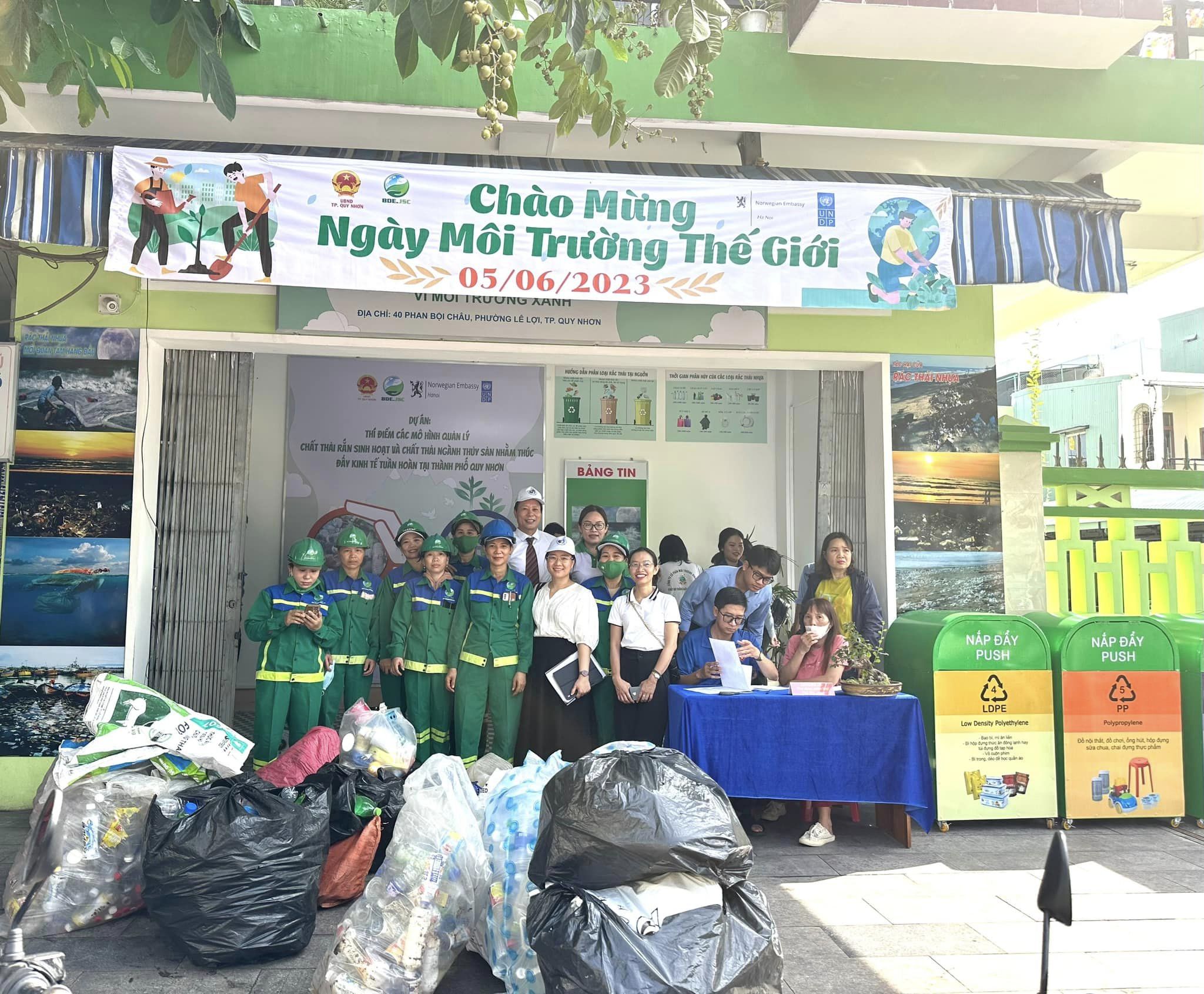
A waste-to-gift event held on the occasion of World Environment Day 2023
The MRF Fund has been actively deployed to facilitate the collection of plastic scrap from various sources in Quy Nhon city, including the Long My landfill. As of December 2023, the total recovered volume has surpassed 67 tons, serving as input material for the MRF. Low-quality plastic sources, such as packaging and disposable plastic, retrieved from the Long My landfill, are expected to contribute to the production of recycled items like plastic bricks and bars. According to the outlined plan, approximately 30 sets of tables and chairs, along with 1,000 square meters of tile floors made from recycled plastic, are scheduled for installation in public spaces within Quy Nhon in 2024.
In November 2023, a significant event unfolded, featuring the introduction of the MRF operating model and the engagement of informal workers. Simultaneously, a collaboration signing ceremony transpired between the Binh Dinh Environment Joint Stock Company and two hotels, and three scrap yards, solidifying their integration into the MRF’s partner network. Moreover, a mechanism was established to collect plastic waste from 200 fishing vessels actively involved in the activity to encourage fishing boats to bring plastic waste back to shore for subsequent processing at the MRF. The sequence of events on November 27 in Binh Dinh also marked a pivotal moment – the launch of the Informal Workers Club in Quy Nhon. This club serves as a platform to connect and inspire the active participation of these workers within the network dedicated to the collection and supply of input plastic wastes to the MRF.
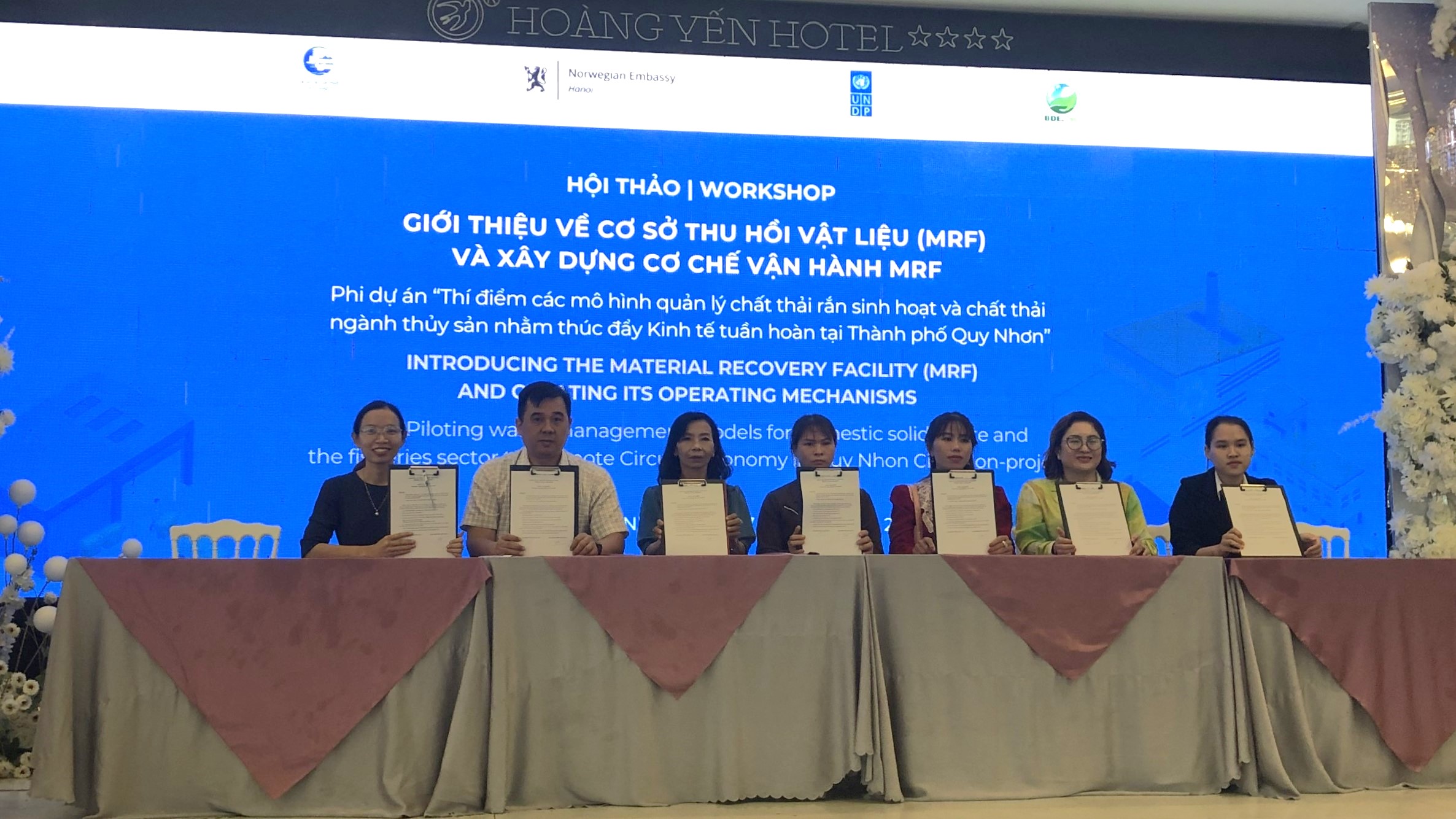
Signing ceremony for cooperation between the Binh Dinh Environment Joint Stock Company and owners of hotels and waste buyers
To streamline the collection and transportation of plastic scrap to the MRF, with the support of the Japanese Embassy, UNDP has handed over four specialized electric waste collection trucks to the Quy Nhon City People’s Committee. These e-trucks are poised to play a pivotal role in establishing environmentally friendly routes for transporting plastic wastes to the MRF. Their contribution aligns with the broader objective of transforming Quy Nhon into a city for circular economy practices, characterized by low emissions.
The MRF in Binh Dinh is currently progressing through the stages of warehouse construction and equipment system installation, with plans for official operations to commence in the first quarter of 2024. Its operation is anticipated to create employment opportunities for informal workers and result in a concrete reduction in the strain on the local solid waste management system, achieved by diverting waste from landfills. This project stands as a quintessential example of successful public-private cooperation, marked by the active involvement of private sector entities, including collection companies, waste buyers, and recycling enterprises, whose collaborative efforts play a crucial role in closing the value chain of plastic waste in Quy Nhon city.
Contact
For any inquiries or concerns, please feel free to reach out to Ms. Hoang Thi Dieu Linh, Waste and Circular Economy Officer, at hoang.thi.dieu.linh@undp.org.





